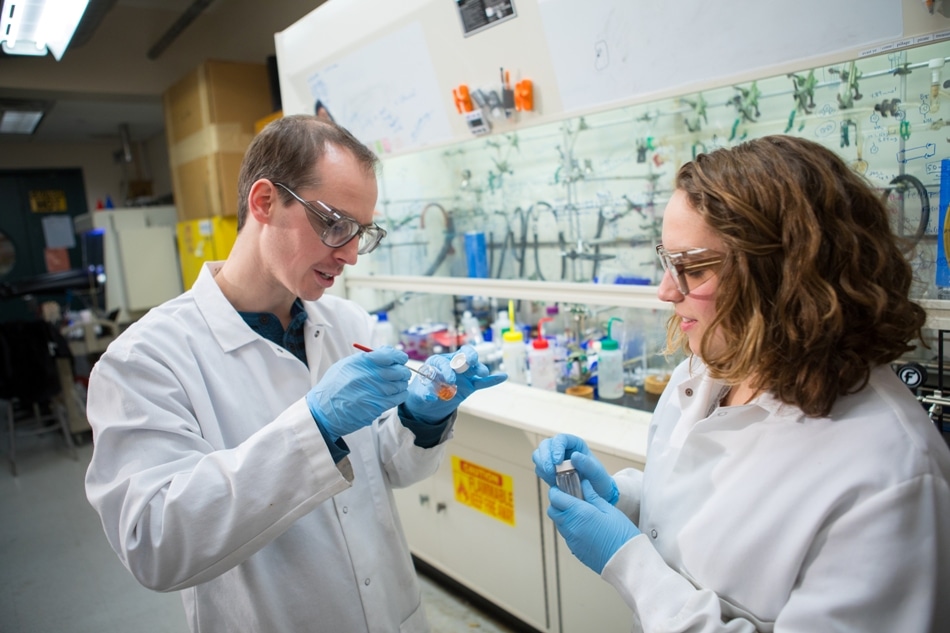Jun 1 2018
When it comes to hydrogen fuel cells, cofacial cobalt porphyrins are considered better than platinum. Only a chemist is probably aware of such a compound. But these moleculescould be the next huge advance in alternative energy.
 University at Buffalo Assistant Professor Timothy Cook (left) led the study, with Amanda Oldacre, UB PhD graduate in chemistry (right), as first author. (Credit: Douglas Levere/University at Buffalo)
University at Buffalo Assistant Professor Timothy Cook (left) led the study, with Amanda Oldacre, UB PhD graduate in chemistry (right), as first author. (Credit: Douglas Levere/University at Buffalo)
Cofacial cobalt porphyrins enable chemical reactions that generate power from hydrogen and oxygen. These compounds can self-assemble in the lab from lego-like chemical building blocks that are engineered to fit together. It is a shake-and-bake technology: Researchers incorporate the pieces to a flask, stir them together, and add heat. Over time, the building blocks combine together in the right places to form the end complexes.
The material is inexpensive and easy to make in large quantities. This makes it a suitable candidate for substituting expensive platinum catalysts used in hydrogen fuel cells at present, says Timothy Cook, PhD, assistant professor of chemistry in the University at Buffalo College of Arts and Sciences, whose team developed the new self-assembled compounds.
In the future, such technology could enable automakers to cut down the price of hydrogen cars, making the eco-friendly vehicles accessible to more consumers. Low-cost fuel cells could also motivate the development of other hydrogen-powered devices, such as backup generators. Hydrogen is said to be a clean energy source as fuel cells release only water as a byproduct.
To bring down the price of hydrogen vehicles and make them a realistic option for more people, we need a catalyst that’s cheaper than platinum. “The catalyst we made can be self-assembled in huge quantities. It has ruthenium and cobalt in it — much cheaper metals — and, yet, it works as well or better than a commercially available platinum catalyst that we tested alongside it.”
Timothy Cook, University of Buffalo
A research describing the new material was reported on May 29 in Chemistry: A European Journal. Cook’s co-authors included first author Amanda N. Oldacre, a recent UB chemistry PhD graduate; UB chemistry PhD student Matthew R. Crawley; and Alan E. Friedman, PhD, research associate professor of materials design and innovation in the UB School of Engineering and Applied Sciences.
A self-manufacturing catalyst
Cook’s lab studies in molecular self-assembly, a robust process for developing new materials.
When I think about molecular self-assembly, I always think about Legos. You have building blocks that are designed to fit together, like pieces of a puzzle. These building blocks are attracted to each other, and when you put them together and add energy, they come together on their own.
Self-assembly is a great way to make a complex molecule. Usually, to synthesize a new material, you have to add pieces one by one, which takes time and money. Molecular self-assembly is faster — it’s a one-step process.”
Timothy Cook, University of Buffalo
Cofacial cobalt porphyrins comprise two flat molecules known as cobalt porphyrins, which are arranged on top of each other like sandwich bread and connected by ruthenium “clips.”
To form the final compounds, Cook’s lab engineered porphyrins and clips possessing chemical properties that guaranteed they would connect to each other at the right spots. The team then blended a solution of the porphyrins with the clips and added heat. Within two days, the pieces had self-assembled to form the cofacial cobalt porphyrins.
A catalyst inspired by nature
Similar to the platinum catalyst they are built to replace, the cofacial cobalt porphyrins enable a chemical reaction in hydrogen fuel cells known as oxygen reduction. This requires splitting an oxygen molecule into two separate oxygen atoms that can then join with hydrogen to form water—an interaction that generates energy.
Researchers have been aware for some time that porphyrins are ideal for grabbing and splitting oxygen: In the human body, iron-based versions of these molecules are responsible for helping to transform the oxygen one breathes into water, discharging energy in the process, Cook says.
But developing artificial porphyrin structures that serve as catalysts has been tough, he adds. The process of developing these compounds is typically expensive, involving a number of steps and producing very little material towards the end.
It is truly rewarding to work on the fundamental chemistry of this project, which could have a large impact on carbon-neutral energy conversion,” says Oldacre, the first author. Using self-assembly techniques, we are able to make cheaper materials in 48 hours, without the difficult, time-consuming purification steps that other methods for synthesizing new compounds require.”
Dr. Amanda Oldacre
Self-assembly solves these issues: Cook’s team formed 79 g of cofacial cobalt porphyrins for every 100g of starter material—a lot better than the less than 1% yield that other labs have reported when making similar materials. Furthermore, his team was able to easily swap out and examine ruthenium clips of various lengths to tweak the compound’s electrochemical qualities with a focus on designing a perfect catalyst.
Better Than Platinum? A New Catalyst for Hydrogen Fuel Cells | University at Buffalo
Better than platinum? A new catalyst for hydrogen fuel cells